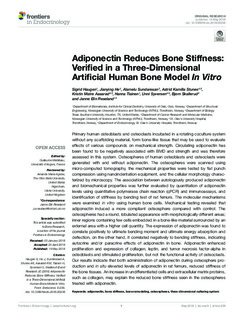| dc.contributor.author | Haugen, Sigrid | |
| dc.contributor.author | He, Jianying | |
| dc.contributor.author | Sundaresan, Alamelu | |
| dc.contributor.author | Stunes, Astrid Kamilla | |
| dc.contributor.author | Aasarød, Kristin Matre | |
| dc.contributor.author | Tiainen, Hanna | |
| dc.contributor.author | Syversen, Unni | |
| dc.contributor.author | Skallerud, Bjørn Helge | |
| dc.contributor.author | Reseland, Janne Elin | |
| dc.date.accessioned | 2018-09-07T12:33:52Z | |
| dc.date.available | 2018-09-07T12:33:52Z | |
| dc.date.created | 2018-05-06T17:36:14Z | |
| dc.date.issued | 2018 | |
| dc.identifier.citation | Frontiers in Endocrinology. 2018, 9:236 1-12. | nb_NO |
| dc.identifier.issn | 1664-2392 | |
| dc.identifier.uri | http://hdl.handle.net/11250/2561513 | |
| dc.description.abstract | Primary human osteoblasts and osteoclasts incubated in a rotating coculture system without any scaffolding material, form bone-like tissue that may be used to evaluate effects of various compounds on mechanical strength. Circulating adiponectin has been found to be negatively associated with BMD and strength and was therefore assessed in this system. Osteospheres of human osteoblasts and osteoclasts were generated with and without adiponectin. The osteospheres were scanned using micro-computed tomography, the mechanical properties were tested by flat punch compression using nanoindentation equipment, and the cellular morphology characterized by microscopy. The association between autologously produced adiponectin and biomechanical properties was further evaluated by quantitation of adiponectin levels using quantitative polymerase chain reaction (qPCR) and immunoassays, and identification of stiffness by bending test of rat femurs. The molecular mechanisms were examined in vitro using human bone cells. Mechanical testing revealed that adiponectin induced a more compliant osteosphere compared with control. The osteospheres had a round, lobulated appearance with morphologically different areas; inner regions containing few cells embedded in a bone-like material surrounded by an external area with a higher cell quantity. The expression of adiponectin was found to correlate positively to ultimate bending moment and ultimate energy absorption and deflection, on the other hand, it correlated negatively to bending stiffness, indicating autocrine and/or paracrine effects of adiponectin in bone. Adiponectin enhanced proliferation and expression of collagen, leptin, and tumor necrosis factor-alpha in osteoblasts and stimulated proliferation, but not the functional activity of osteoclasts. Our results indicate that both administration of adiponectin during osteosphere production and in situ elevated levels of adiponectin in rat femurs, reduced stiffness of the bone tissues. An increase in undifferentiated cells and extracellular matrix proteins, such as collagen, may explain the reduced bone stiffness seen in the osteospheres treated with adiponectin. | nb_NO |
| dc.language.iso | eng | nb_NO |
| dc.publisher | Frontiers Media | nb_NO |
| dc.rights | Navngivelse 4.0 Internasjonal | * |
| dc.rights.uri | http://creativecommons.org/licenses/by/4.0/deed.no | * |
| dc.title | Adiponectin reduces bone stiffness; verified in a 3D artificial human bone model in vitro | nb_NO |
| dc.type | Journal article | nb_NO |
| dc.type | Peer reviewed | nb_NO |
| dc.description.version | publishedVersion | nb_NO |
| dc.source.pagenumber | 1-12 | nb_NO |
| dc.source.volume | 9:236 | nb_NO |
| dc.source.journal | Frontiers in Endocrinology | nb_NO |
| dc.identifier.doi | 10.3389/fendo.2018.00236 | |
| dc.identifier.cristin | 1583703 | |
| dc.description.localcode | Copyright © 2018 Haugen, He, Sundaresan, Stunes, Aasarød, Tiainen, Syversen, Skallerud and Reseland. This is an open-access article distributed under the terms of the Creative Commons Attribution License (CC BY). | nb_NO |
| cristin.unitcode | 194,64,45,0 | |
| cristin.unitcode | 194,65,15,0 | |
| cristin.unitname | Institutt for konstruksjonsteknikk | |
| cristin.unitname | Institutt for klinisk og molekylær medisin | |
| cristin.ispublished | true | |
| cristin.fulltext | original | |
| cristin.qualitycode | 1 | |

